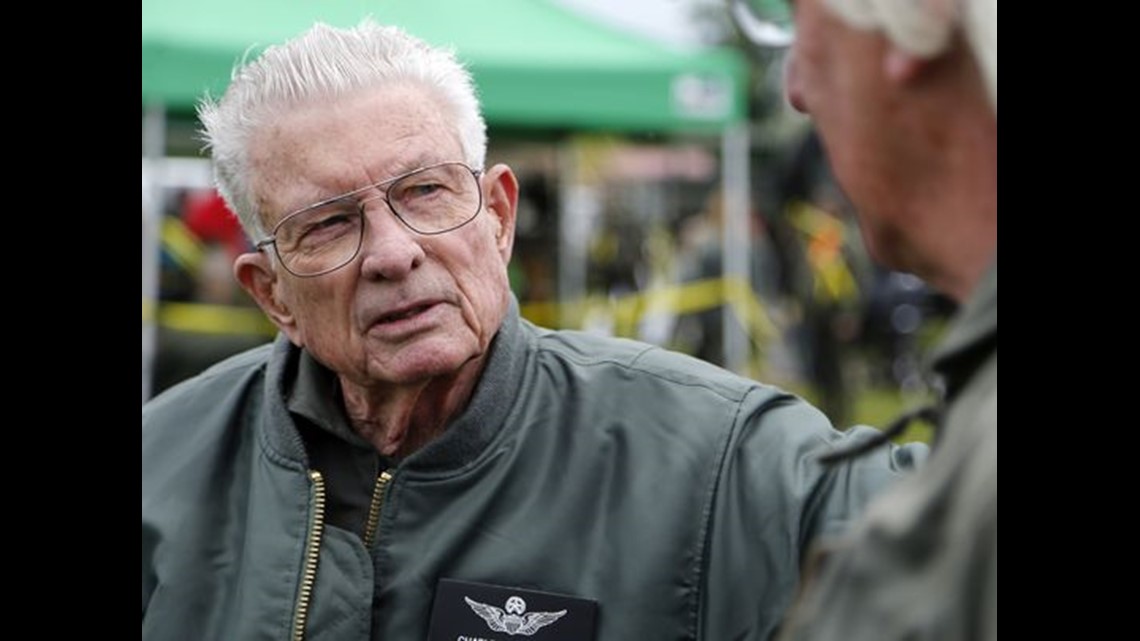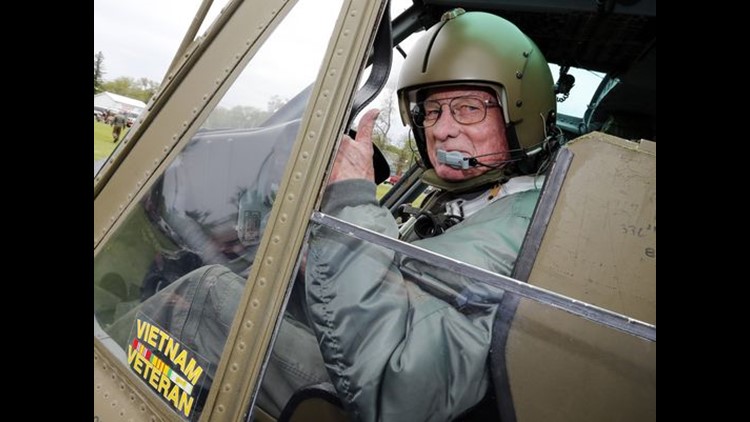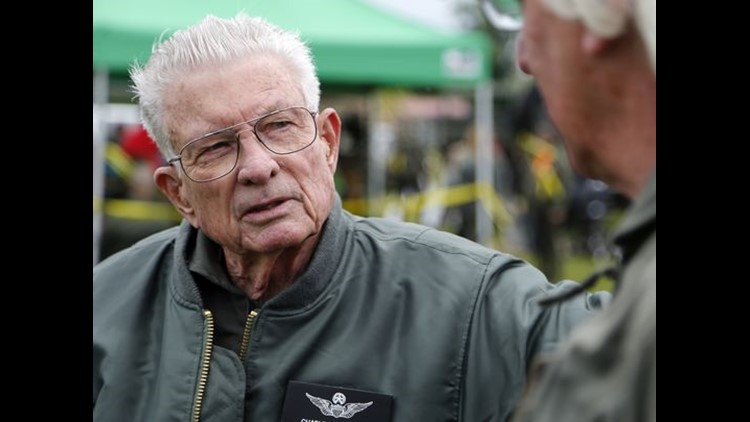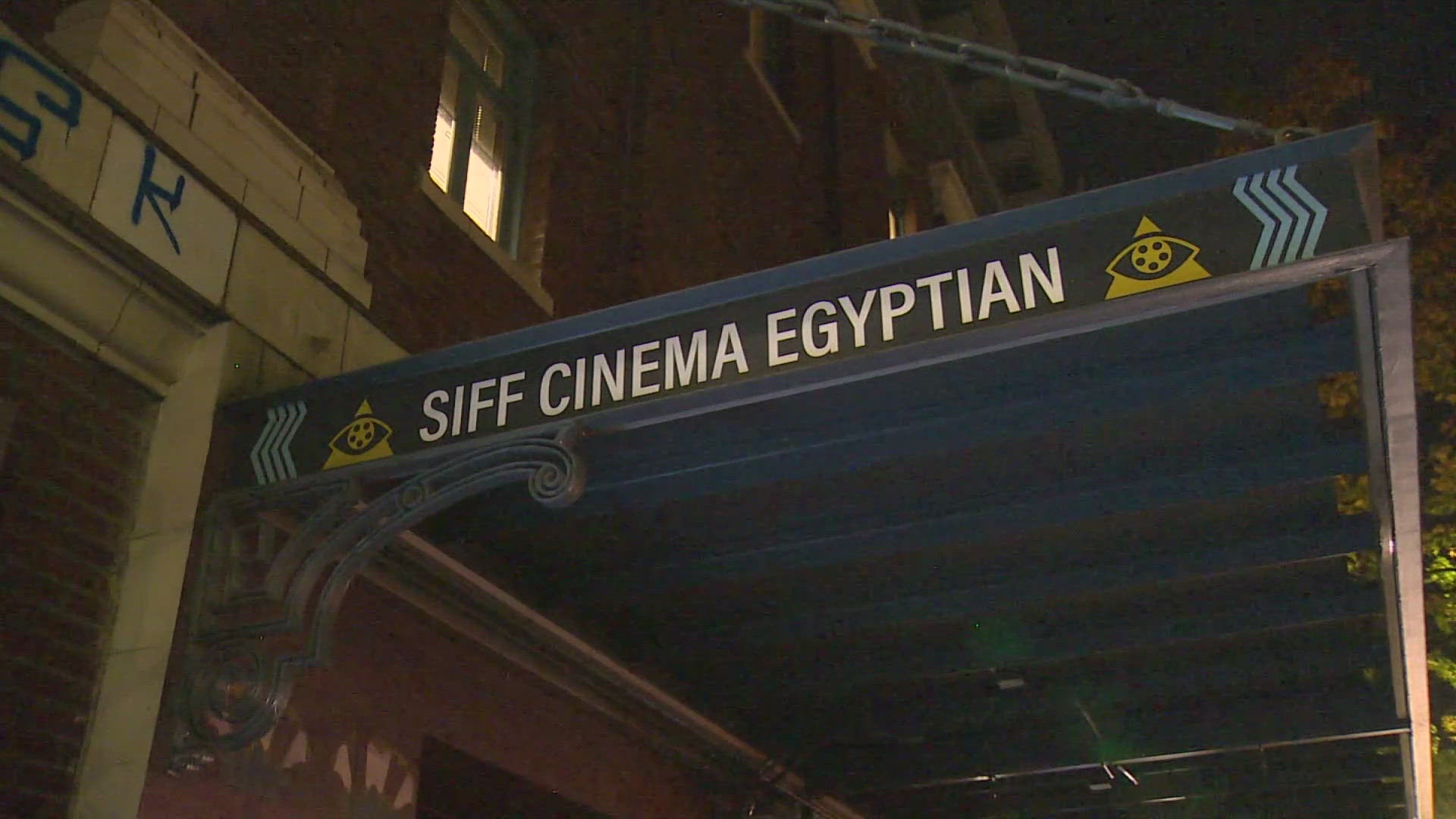WASHINGTON — The details of the heroism that will see Charles Kettles awarded the Medal of Honor at the White House come back clearly and quickly even five decades later.
The White House announced Tuesday afternoon that Kettles would receive the award from President Obama on July 18.
Kettles, 86, recalls the events of May 15, 1967: flying his UH-1 helicopter time after time after time into dizzying, withering fire to save the lives of dozens of soldiers ambushed by North Vietnamese troops in the Song Tau Cau river valley; nursing the shot-up, overloaded bird out of harm’s way with the final eight soldiers who’d been mistakenly left behind.
“With complete disregard for his own safety …” the official narrative of that day reads. “Without gunship, artillery, or tactical aircraft support, the enemy concentrated all firepower on his lone aircraft … Without his courageous actions and superior flying skills, the last group of soldiers and his crew would never have made it off the battlefield.”
Kettles, born and bred and retired in Ypsilanti, Mich., remembers how he felt after he touched down nearly 50 years ago for the last time, finally safe. Unrattled and hungry.
“I just walked away from the helicopter believing that’s what war is,” Kettles told USA TODAY. “It probably matched some of the movies I’d seen as a youngster. So be it. Let’s go have dinner."
Kettles’ actions were documented and saluted long ago. He was awarded the second-highest award for bravery, the Distinguished Service Cross. And that, he thought, was that. Kettles completed another tour in Vietnam, retired from the Army as a lieutenant colonel and opened an auto dealership with his brother.
That's where the story would end, if not for William Vollano, an amateur historian who was interviewing veterans for the Veterans History Project. Vollano's prodding led the Army to reopen Kettles’ case and determine that his actions merited the Medal of Honor. Coincidentally, the military is also reviewing the actions of hundreds more troops in the post-9/11 era to see if they, too, should receive upgrades of their service crosses and Silver Stars.


May 15, 1967
On that May morning in Vietnam, Maj. Kettles’ and several other helicopter pilots ferried about 80 soldiers from the 1st Brigade of the 101st Airborne Division to a landing zone near the Song Tra Cau River. The river, just eight or 10 feet above sea level, drifted past a 1,500-foot hill.
“Very steep, which set them up for an ambush,” Kettles recalls. “Which did happen.”
Hundreds of North Vietnamese soldiers, dug into tunnels and bunkers, attacked the Americans with machine guns, mortars and recoilless rifles.
“Two or three hours after they were inserted, they had been mauled over and the battalion commander called for reinforcements,” Kettles says.
Kettles volunteered to fly in reinforcements and to retrieve the wounded and dead. As they swooped in to land, the North Vietnamese focused their fire on the helicopters. Soldiers were killed before they could leap from the aircraft, according to the official account of the fight.
Air Force jets dropped napalm on the machine gun positions overlooking the landing zone, but it had little effect. The attack continued, riddling the helicopters with bullets. Kettles refused to leave, however, until the fresh troops and supplies had been dropped off and the dead and wounded crowded aboard to be flown out.
Kettles ran the gantlet again, bringing more reinforcements amid mortar and machine gun fire that seriously wounded his gunner and tore into his helicopter. The crew from another helicopter reported to Kettles that fuel was pouring from his aircraft. Kettles wobbled back to the base.
"Kettles, by himself, without any guns and any crew, went back by himself," said Roland Scheck, a crew member who had been injured on Kettles' first trip to the landing zone that day. "Immediately, all the pilots and copilots in the company decided, 'This is Medal of Honor material right there.'"
"I don’t know if there's anyone who's gotten an Medal of Honor who deserved it more," he said. "There's no better candidate as far as I'm concerned."
Photos: Charles Kettles will be awarded the Medal of Honor
The Final Run
At about 6 p.m., the infantry commander radioed for an immediate, emergency evacuation of 44 soldiers, including four from Kettles’ unit whose helicopter was destroyed at the river. Kettles volunteered to lead the flight of six evacuation helicopters, cobbled together from his and another unit.
“Chaotic,” Kettles says. “The troops simply went to the first helicopter available.”
Just one soldier scrambled into his helicopter. Told that all were safe and accounted for, Kettles signaled it was time to return to base.
“The artillery shut down, the gunships went back,” Kettles said. “No reason for them to stay anymore. The Air Force shut down. We climbed out to about 1,400 feet, a 180-degree turn back toward base camp and the hospital.”
That’s when word reached Kettles that eight soldiers had been left behind.
“They had been down in the river bed in a last ditch defensive effort before the helicopters loaded,” Kettles said. “I assured the commander I would go back in and pick them up.”
Kettles took control of the helicopter from the co-pilot and plummeted toward the stranded soldiers.
The North Vietnamese trained all their fire on Kettles. As he landed, a mortar round shattered the windshields and damaged the tail and main rotor blade. The eight soldiers piled on board, raked by rifle and machine-gun fire. Jammed beyond capacity, the helicopter “fishtailed” several times before Kettles took the controls again from his co-pilot. The only way out, Kettles recalls, was to skip along the ground, gaining enough speed to get the helicopter in the air.
“If not we were going to go down the road like a two-and-a-half ton truck with a rotor blade on it,” Kettles says.
After five or six tries, Kettles got off the ground. Just then, a second mortar round slammed into the tail.
“That caused the thing to lurch forward,” he says. “I don’t know if that helped much. I still had a clean panel, that is, the emergency panel. There weren’t any lights.
The helicopter was still doing what it was supposed to do even though it was, I guess, pretty badly (damaged). We got out of there.”


The Medal of Honor
Kettles acknowledges it was an extraordinary day, one that he thinks about but doesn’t dwell on. He and the other helicopter pilots and crew performed as they were trained, followed orders, completed their mission. Simple as that.
The Medal of Honor, he says, “belongs to them certainly as much as myself. I just happened to be the lead position where the decisions were mine, properly so.
“For them, unfortunately all they could do was follow. And they did. They did their jobs. They’re as deserving as I am certainly. That’s what it means to me.”
For dozens of soldiers, especially the last eight, Kettles' decision kept their names from being etched on the black granite wall of the Vietnam War memorial here in Washington with the 58,000 others who died in the war.
“The eight who got out of there who aren’t on that wall,” Kettles says. “That’s what matters.”




